Beginnings
A drift of history in a wrinkle of time
Tour Armenia
A CONCEPT OF TIME ANCIENT ROOTS CITY-STATES ORIGINS OF LANGUAGE THE INDO-EUROPEANS
A Concept of Time
Armenia's culture is older than Europe, it is older than Greece or Rome. While the first record of the word “Armenia” (called “Arminya”) and its people (called “Armena”) are found on clay tablets during the reign of the Achaemenid King Darius I (1st millennium BC), the Armenian culture has much older roots, it goes back further than Mesopotamia, before Egypt, China and the Indus civilization. To some it even goes back to the beginning. Of everything.
But what does this really mean? If you try to put things into perspective by comparing Armenia's history to other cultures, you can see it in a relative place in time. Still, many people probably can't fathom much more than a few hundred years, so if we toss out 1000’s of years of time, it may not mean a lot. After all, one's BC is anther's BWM (Before Wal-Mart).
Some people imagine history compared to their own country's. By this count, the USA is 220 years old, France is 15 X older then the USA, Egypt 36 X older and the earliest civilizations we know about (including ancestral Armenians) are 100 X older than the USA. All that math still somehow doesn't put it into perspective, does it?
Others think of time in terms of whom they know, the oldest ones, and how many more of those lives there must have been to go back to a place in history. My aunt can trace our family to Elizabethan England and Feudal France. But that is not even 500 years, and old history is 18 times greater than that. Prehistory is impossible to fathom, because it is millions of years old, and we tend to describe 10,000 years in a few words. Easy to read, but silly to try and comprehend.
Maybe the best way to look at it is to think of forever, and just when you begin to get a little scared of that thought, and feel really insignificant in the whole scheme of things, start from there. Before cities, before tools, before fire, when people didn't have time, they simply lived it. They worshipped the sun because it meant the difference between staying warm or cold, when the world was covered with huge masses of ice in its Northern regions, and when people moved from place to place just to stay alive. They lived in groups because they had to defend themselves against the world, and they worshipped the world because it let them live. They fought with other tribes over resources; water, hunting and land. They told stories, pieces of which are on cliff drawings going back 25,000 years before we live. These people are the beginning of all modern cultures, the greatest great grandparents we have. The Armenian plateau has revealed these earliest ancestors, through one to two million-year-old skeletons and simple hunting tools.
Ancient Roots
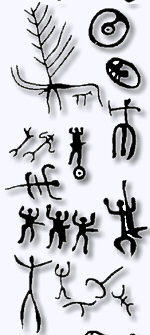 The first record of human inhabitants in Armenia are Homo sapiens skeletal remains discovered in the Hrazdan River gorge near present day Bjini, dated one to two million years BC. Other prehistoric sites include a ca. 90,000 BC settlement in Yerevan, the first signs of the use of obsidian to make knives, spear heads and tools. Traces of stored grain were discovered at the sight, indicating mankind moved from a hunter-gatherer society to a collective unit much earlier than previously thought. The first record of human inhabitants in Armenia are Homo sapiens skeletal remains discovered in the Hrazdan River gorge near present day Bjini, dated one to two million years BC. Other prehistoric sites include a ca. 90,000 BC settlement in Yerevan, the first signs of the use of obsidian to make knives, spear heads and tools. Traces of stored grain were discovered at the sight, indicating mankind moved from a hunter-gatherer society to a collective unit much earlier than previously thought.
Stone carvings left on the side of the Geghama Mountain Range between Yerevan and Lake Sevan and near Lake Van are the strongest evidence of early civilization. The stone carvings (or pictograms) are dated to the Paleolithic (ca. 20,000 - 12,000 BC), Mesolithic (12,000 - 7,000 BC) and Neolithic (7,000 -5,000 BC) eras.
The earliest pictograms in Armenia mostly show animals (wild deer, rabbits and the first signs of domesticated dogs and goats), water and simple outlines of dwellings, pointing to either an enclosed area (symbolizing land or territory), or perhaps a cave, since there is only one entrance drawn. They concern the most important parts of people's lives: staying together, finding protection from the elements, and finding things to eat. Things haven't changed that much in the world, have they?
By the Mesolithic period, the population of the world had grown to about 3 million, and the drawings give a little hint as to how humans became successful at propagating their own kind: drawings show herds of animals, including mammoths and antelope. The drawings of mammoths might by souvenirs of victory at a hunt, and are a far step away from the little rabbits shown scurrying away in the earlier period. Some think they show a concerted hunt effort, since only groups could bring down a mammoth, while any one could snare a rabbit. Human figures are developed in the Mesolithic era. At first represented by a vertical line with a circle for the head, figures began to include outstretched arms (a cross-form shape) and arms raised above. Another figure includes waving arms, showing one of the first representations of movement.
City-States
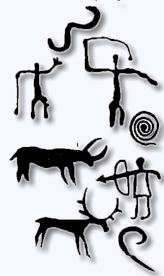 Jump forward 4000 years from the end of the Paleolithic Era. People are farming, and gathering together into villages and towns. The use of fire and metal to create tools and weapons puts a significant dent on the threat of being attacked by four-legged carnivores (two-legged ones are another story), and a rich storytelling and religious culture begins. People no longer worship the elements just for survival, they give the elements a human spirit, and to invest them with another world. We're going back to the time of earliest cultures in Asia Minor, the Mesopotamian “cradle of civilization”. Jump forward 4000 years from the end of the Paleolithic Era. People are farming, and gathering together into villages and towns. The use of fire and metal to create tools and weapons puts a significant dent on the threat of being attacked by four-legged carnivores (two-legged ones are another story), and a rich storytelling and religious culture begins. People no longer worship the elements just for survival, they give the elements a human spirit, and to invest them with another world. We're going back to the time of earliest cultures in Asia Minor, the Mesopotamian “cradle of civilization”.
Mesopotamia was located between the Euphrates and the Tigres rivers, in present day Iraq, and excavations there show some of the earliest unified groups of people moving from caves to mud brick cities and farming--hey, for people who spent thousands of years in caves, mud was considered a miracle of construction! Mud is an excellent material for building, it is cheap and readily available (just add water and a binding agent like clay or straw, let it dry in pre-cut blocks, and keep the rain off. If it washes away, recycle), and large buildings can be created from it. In Central Asia along the Incense Trail, there are cities with buildings four and five stories tall made from this wunderbar stuff.
By 7000 BC, much of the land between the Persian Gulf and Egypt became a desert. We aren’t sure exactly why (theories keep the weather folks busy), but it forced people into smaller living areas centered on rivers and oases. It was a time when the “fertile crescent” in Asia Minor developed as a center of civilization, laying as it was between several great rivers that ran from the Armenian Plateau into present day Syria, Iraq and Iran. The crescent encompassed vastly different cultures, each of which mentions a beginning or forerunner culture to the North.
Mesopotamia was located between the Euphrates and the Tigris rivers, in present day Iraq, and excavations show some of the earliest settlements (ca. 9000 BC), which developed mud-brick as a construction material--hey, for people who spent thousands of years in caves, mud was a miracle of construction!
The land in Mesopotamia had to be irrigated since it is fertile but parched. The Euphrates and the Tigris rivers are plentiful with water, but they are much like the Nile--if you divert the water, good for you, you get to use it. If you don’t, then it just runs on down to the Persian Sea. By the 4th millennium BC, Mesopotamia was one of the wealthiest agricultural region in the world, including large-scale wheat and grain farming.
However, wheat is not a native grain to Mesopotamia. On the Armenian plateau the domestication of wheat began about 15,000 years ago. Wheat, barley and rice kernels have been excavated and dated to that period, with evidence of large scale agriculture; the descendants of those early strains of wheat and rice can still be found near Garni, Yerevan and Areni; the barley bringing forth more than wheat-- a very early brewing process for the forefather of beer has also been found in Armenia.
Origins of Language
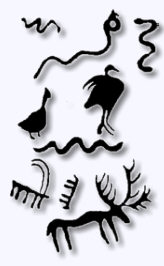 Among the people who lived in Mesopotamia were the Sumerians, who were a Hamito-Semitic race inhabiting the area beginning about 7000 BC. They rose to prominence around 4000 BC, and created one of the first major cities, Ur, around 3500 BC. The Sumerians are the forefathers of an early empire Akkad and, later on, their cousins the Babylonians and Assyrians. Among the people who lived in Mesopotamia were the Sumerians, who were a Hamito-Semitic race inhabiting the area beginning about 7000 BC. They rose to prominence around 4000 BC, and created one of the first major cities, Ur, around 3500 BC. The Sumerians are the forefathers of an early empire Akkad and, later on, their cousins the Babylonians and Assyrians.
Sumerians have been attributed with creating the wheel and perfecting one of the earliest writing methods--the cuneiform. Like Egyptian hieroglyphs, cuneiform relied on pictogram symbols to express ideas, but the Sumerians developed a short-cut method of communicating that expressed thoughts into a sentence structure. We tend to think of cuneiform as wedge shaped slashes on clay tablets and hieroglyphs as elaborate pictures etched and painted on stone, but both were basically pictures of ideas. Between 400-600 cuneiform pictographs were used in Sumeria, as opposed to the 30 or so letters used in most modern alphabets. Modern hieroglyphic languages like Chinese and Japanese use as many as 4000 characters in their writing systems.
Pictograms in Armenia from the Mesolithic period show a more sophisticated iconography than those from the Paleolithic period, and a greater variety in the representations of figures. People are shown not only in standing positions, but holding weapons, bending and in movement. There is one with three figures that could be illustrating a dance, and another that looks as though the person is holding the body of another person.
Another pictogram in Armenia illustrates a spiral with a jagged tail leading to a cross that leads on its upper stem to a smaller cross. The carving is considered both a representation of a celestial event and an early compass, since the cross points to the four cardinal points (North, South, East and West). The cross is a precursor to the Sacred Swastika, which was a depiction of the sun spiraling in the sky, and became associated with power or god. So many celestial designs appear in fixed locations, archeologists believe ancestral Armenians were moving from simple worship to the beginning of mapping the night sky. The compass figures are especially remarkable, since they indicate a culture that was beginning to navigate the world around them. Navigation requires accurate mapping and understanding of the night sky, something the people who carved the symbols on the Geghama Lehr must have already begun to master.
As a writing symbol, the spiral may be the first description of movement, showing a wheel in motion as it tumbles down the side of a hill and continues on to a major intersection or town. Perhaps it is both a map and movement, showing the way wheeled vehicles can go over the mountain to a place where flat roads lie. The wheel, which the Sumerians are credited with inventing by 6500 BC, made transportation a lot easier (if bumpy over those steps and rocky mountainsides), and can be considered one of the first inventions of technology. The symbol of the wheel in Armenia actually goes back to the Mesolithic period (12,000-7,000 BC), which may show its invention (at least its use) in the Armenian Plateau.
Look more closely at the human figures, though, and linguists claim you are looking at the beginnings of an Indo-European alphabet, proof to the origination of the Indo-Europeans in the Armenian Plateau.
The Indo-Europeans
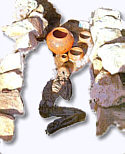 The Armenian language is part of the Indo-European language family. The name ‘Indo-European’ is itself a variation of ‘Indo-Aryan’, encompassing Sanskrit, Slavic, Germanic and Romance languages, and take in more territory, speaking wise, than any other on earth. The Armenian language is part of the Indo-European language family. The name ‘Indo-European’ is itself a variation of ‘Indo-Aryan’, encompassing Sanskrit, Slavic, Germanic and Romance languages, and take in more territory, speaking wise, than any other on earth.
One of the greatest evolutions in history occurred when Indo-Europeans began to migrate throughout Asia and Europe. Classical historians put this event sometime in the 3rd millennium BC and thought the source for Indo-Europeans were someplace in Central Asia. History is always being reinvented, though, in the face of new discoveries, and the source of the Indo-European culture is now figured to be on or near the Armenian Plateau, with migrations into Asia and Europe beginning as early as 7,000 BC.
Looking for an Indo-European Proto-Language, linguistic specialists have settled on a crescent of land that curves around the southern shores of the Black Sea east across the Armenian Plateau and north to the Caucasus Mountains. Propelled by the agricultural revolution that began around 15,000 BC, created a food surplus that promoted villages and city-states and a population growth which propelled migrations into neighboring lands.
Map: Migration of Indo-Europeans
Moving first into Eastern Anatolia and the Iranian Plateau, then into Central Asia and India to the East and into the Balkans and Europe to the West, successive waves of Indo-Europeans culminated in a ca. 3000-2000 BC migration into the Eastern Mediterranean which hallmarks the beginnings of the Hittite and Greek Doric (Dorian) cultures. From there the culture made a full circle around 1200 BC, when Thraco-Phrygian tribes (among the losers of the Trojan War) entered the Armenian Plateau and re-introduced a much developed Indo-European language to the originating territory.
The migrations set a time line for the break-up of the Proto-language into smaller groups, one of which is called the Greek-Armenian-Indo-Iranian language community, which began around the 4th millennium BC. By the 3rd millennium BC, the community was already subdividing into smaller groups, the primary branches being the Greek-Armenian and Indo-Iranian language communities.
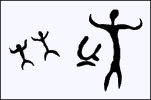 Tablets in the Hattusas archives show that by the middle of the 2nd millennium BC, the Indo-Iranian group had given rise to a language spoken in the Mitanni kingdom on the southeast edge of Anatolia that was already different from older Indian (Sanskrit) and old Iranian. Cretan Mycenaean texts from the same period as Mitanni, deciphered in the 1950's revealed a previously unknown dialect of Greek. By the time the Dorics invaded Greece, the languages had gone their several separate ways from the original Armenian Indo-European mother tongue. Tablets in the Hattusas archives show that by the middle of the 2nd millennium BC, the Indo-Iranian group had given rise to a language spoken in the Mitanni kingdom on the southeast edge of Anatolia that was already different from older Indian (Sanskrit) and old Iranian. Cretan Mycenaean texts from the same period as Mitanni, deciphered in the 1950's revealed a previously unknown dialect of Greek. By the time the Dorics invaded Greece, the languages had gone their several separate ways from the original Armenian Indo-European mother tongue.
One of the branches that entered Central Asia has been called Tocharian, a recent discovery, but one that links the Sanskrit and Armenian languages closely together. Called the Gutians in Babylonian cuneiform inscriptions (Akkadian) dating from the 3rd millennium BC, when King Sargon was building the first great Mesopotamian Empire. Tocharian is linked with the Italo-Celtic branch, suggesting the two groups were associated with each other on the Armenian Plateau before moving their separate ways. For more detailed information see The Early History of Indo-European Languages, by Thomas V. Gamkrelidze and V. V. Ivanov (Scientific American, March 1990, page 110).
In one of the pictograms in Armenia carved during the Mesolithic period there is a representation of a man with both arms raised, his legs slightly bent. The top half of the figure is considered the precursor of the letter for “Ah”, the main root sound in all Indo-European languages, represented in Armenian by the letter “ ”. Speculation is that the first sound made was “ah”, and came to represent “man”, “first” and “one”. The raised arms indicate worship. ”. Speculation is that the first sound made was “ah”, and came to represent “man”, “first” and “one”. The raised arms indicate worship.
In Armenian, the sound ‘Ah’ combined with “R’ forms a second main root, “AR”, which means ‘light', ‘sun’ and ‘god’. Numerous words in Armenian begin with ‘AR’, among them arev (sun) and Ararat. Ararat is a complex word: ‘Ar-Ar’ meaning a greater god, or more than one god, and ‘-at’ a precursor of the Armenian ‘hat’, which means ‘a piece of’. Thus, ‘Ar-ar-at’ is ‘a piece of the gods’, or ‘a piece of creation’.
Others originating in the pictograms include ‘barev’, which in modern Armenian means ‘hello’, but comes from an older root meaning ‘to belong to’, represented in the pictograms as a dwelling or house.
See Evolution of the the Armenian Alphabet
To put this into perspective, the inscriptions on Geghama Lehr show the beginnings of an alphabet and the first indications of the mapping of the cosmos, 1500 years before the rise of the Sumerians, considered the first urban culture. Egypt's first dynasty is still 4000 years away.

Geghama Lehr Rock Carvings
Rock Arts Gallery
Rock Carvings of Siunik
Rock Carvings of Navasar
Elma Parsamian, Archeo-Astronomy (Russian)

 Top
Top

|
